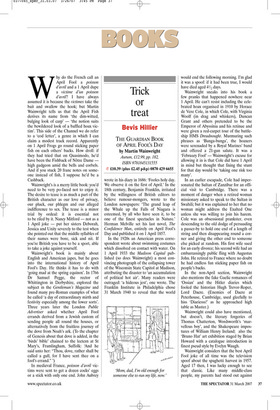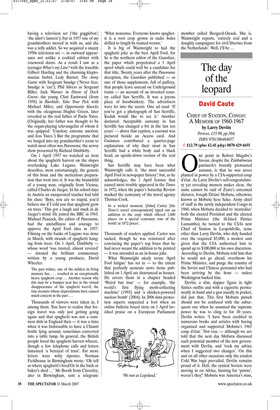Trick or treat
Bevis Hillier
THE GUARDIAN BOOK OF APRIL FOOL’S DAY by Martin Wainwright Aurum, £12.99, pp. 182, ISBN 9781845131555 ✆ £10.39 (plus £2.45 p&p) 0870 429 6655 Why do the French call an April Fool a poisson d’avril and a 1 April dupe a victime d’un poisson d’avril? I have always assumed it is because the victimes take the bait and swallow the hook; but Martin Wainwright tells us that the April Fish derives its name from ‘the dim-witted, bulging look of carp’ — ‘the notion suits the bewildered look of a baffled hoax victim’. This side of the Channel we do refer to a ‘cod letter’, a genre in which I can claim a modest track record. Apparently on 1 April Frogs go round sticking paper fish on each others’ backs. How droll: if they had tried that on Quasimodo, he’d have been the Fishback of Nôtre Dame high gudgeon amid the bells and corbels. And if you stuck 20 franc notes on someone instead of fish, I suppose he’d be a Cashback.
Wainwright’s is a merry little book: you’d need to be very po-faced not to enjoy it. The desire to tease is as much a part of the British character as our love of privacy, our pluck, our phlegm and our alleged indifference to sex. The tease is a minor trial by ordeal: it is essential not to be riled by it. Nancy Mitford — not as a 1 April joke — put her sisters Deborah, Jessica and Unity severely to the test when she pointed out that the middle syllables of their names were bore, sick and nit. If you’re British you have to be a sport, able to take a joke against yourself.
Wainwright’s book is mainly about English and American japes, but he goes into the international history of April Fool’s Day. He thinks it has to do with ‘going mad at the spring equinox’. In 1766 Dr Samuel Pegge, the rector of Whittington in Derbyshire, explored the subject in the Gentleman’s Magazine and found many pre-Roman examples of what he called ‘a day of extraordinary mirth and festivity especially among the lower sorts’. Three years later the London Public Advertiser asked whether April Fool errands derived from a Jewish custom of sending people all round the houses, or alternatively from the fruitless journey of the dove from Noah’s ark. (To the chapter of Genesis about that dove is added, in the ‘birds’ bible’ chained to the lectern at St Mary’s, Framlingham, Suffolk: ‘And he said unto her: “Thou, dove, rather shall be called a gull, for I have sent thee on a fool’s errand.” ’) In medieval France, poisson d’avril victims were sent to get a dozen cocks’ eggs or a stick with only one end. John Aubrey wrote in his diary in 1686: ‘Fooles holy day. We observe it on the first of April.’ In the 18th century, Benjamin Franklin, irritated by the willingness of British editors to believe rumour-mongers, wrote to the London newspapers: ‘The grand leap of the Whale up the Falls of Niagara is esteemed, by all who have seen it, to be one of the finest spectacles in Nature.’ Herman Melville set his last novel, The Confidence Man, entirely on April Fool’s Day and published it on 1 April 1857.
In the 1920s an American press correspondent wrote about swimming costumes which dissolved on contact with water. On 1 April 1933 the Madison Capital published (so does Wainwright) a most convincing photograph of the collapsing tower of the Wisconsin State Capitol at Madison, attributing the disaster to ‘an accumulation of political hot air’. Many readers were outraged: ‘a hideous jest’, one wrote. The Franklin Institute in Philadelphia chose 31 March 1940 to reveal that the world would end the following morning. I’m glad it was a spoof: if it had been true, I would have died aged 41/2 days.
Wainwright sneaks into his book a few pranks that happened nowhere near 1 April. He can’t resist including the celebrated hoax organised in 1910 by Horace de Vere Cole, in which Cole, with Virginia Woolf (in drag and whiskers), Duncan Grant and others pretended to be the Emperor of Abyssinia and his retinue and were given a red-carpet tour of the battleship HMS Dreadnought. Murmuring such phrases as ‘Bunga-bunga’, the hoaxers were serenaded by a Royal Marines’ band and offered a 21-gun salute. It was a ‘February Fool’ — Wainwright’s excuse for allowing it in is that Cole did have 1 April in mind but thought that fixing the stunt for that day would be ‘taking one risk too many’.
In an earlier escapade, Cole had impersonated the Sultan of Zanzibar for an official visit to Cambridge. There was a moment of danger when a retired woman missionary asked to speak to the Sultan in Swahili; but it was explained to her that no woman might address the Exalted One unless she was willing to join his harem. Cole was an obsessional prankster, even descending to the old dodge of persuading a passer-by to hold one end of a length of string and then disappearing round a corner and giving the other end to someone else picked at random. His first wife sued for an early divorce; his second wife had an embarrassingly public fling with Augustus John. He retired to France where no doubt he had endless fun sticking paper fish on people’s backs.
In the non-April section, Wainwright also mentions the fake Gaelic romances of ‘Ossian’ and the Hitler diaries which fooled the historian Hugh Trevor-Roper, Lord Dacre. (Enemies of Dacre at Peterhouse, Cambridge, used gleefully to hiss ‘Diariesss!’ as he approached high table as Master.) Wainwright could also have mentioned, but doesn’t, the literary forgeries of Thomas Chatterton, Wordsworth’s ‘marvellous boy’, and the Shakespeare impostures of William Henry Ireland; also the ‘Bruno Hat’ art exhibition staged by Brian Howard with a catalogue introduction in finest pseud style by Evelyn Waugh.
Wainwright considers that the best April Fool joke of all time was the television spoof about the spaghetti harvest in 1957. Aged 17 then, I was lucky enough to see that classic. Like many middle-class people, my parents had stood out against having a television set (‘the gogglebox’; ‘the idiot’s lantern’); but in 1957 one of my grandmothers moved in with us, and she was a telly addict. So we acquired a snazzy 1950s television set — in outward appearance not unlike a cocktail cabinet with rosewood doors. As a result I saw as a teenager What’s my Line? with the irascible Gilbert Harding and the charming kleptomaniac Isobel, Lady Barnet; The Army Game with Sergeant Snudge (‘Never fear, Snudge is ’ere’); Phil Silvers as Sergeant Bilko; Jack Warner in Dixon of Dock Green; the young Clint Eastwood (from 1958) in Rawhide; Take Your Pick with Michael Miles; and Opportunity Knocks with the oleaginous Hughie Green, later revealed as the real father of Paula Yates. (Originally, her father was thought to be the organ-playing televangelist of whom it was quipped: ‘Unction; extreme unction; and Jess Yates.’) But the programme that we barged into my grandmother’s room to watch most often was Panorama, the newsy show presented by Richard Dimbleby.
On 1 April 1957 we watched an item about the spaghetti harvest on the slopes overlooking Lake Lugano. Wainwright describes, most entertainingly, the genesis of this hoax and the meticulous preparation that went into it. It was the brainchild of a young man, originally from Vienna, called Charles de Jaeger. In his school days in Austria an exasperated teacher had told his class: ‘Boys, you are so stupid, you’d believe me if I told you that spaghetti grew on trees.’ This got a laugh and stuck in de Jaeger’s mind. He joined the BBC in 1943. Michael Peacock, the editor of Panorama, had the unstuffiness and courage to approve the April Fool idea in 1957. Filming on the banks of Lugano was done in March, with strands of spaghetti hanging from trees. On 1 April, Dimbleby whose word ‘was trusted, almost revered’ — intoned the brilliant commentary written by a young producer, David Wheeler:
The past winter, one of the mildest in living memory has . . . resulted in an exceptionally heavy spaghetti crop ... Another reason why this may be a bumper year lies in the virtual disappearance of the spaghetti weevil, the tiny creature whose depredations have caused much concern in the past . . .
Thousands of viewers were taken in, I among them. You have to realise that foreign travel was only just getting going again and that spaghetti was not a common dish in England then — it was a time when it was fashionable to have a Chianti bottle lying around, sometimes converted into a table lamp. In general, the British people loved the spaghetti harvest wheeze, though a few telephone calls and letters lamented ‘a betrayal of trust’. Far more letters were witty ripostes. Norman Fieldhouse in Birmingham wrote: ‘Oh tell us where spaghetti’s bred/Or in the bush or baker’s shed ...’ Mr Booth from Claverley, also in Birmingham, sent a telegram: ‘What nonsense. Everyone knows spaghetti is a root crop grown in radio holes drilled to length by trained worms.’ It is big of Wainwright to hail the spaghetti joke as the best April Fool, for he is the northern editor of the Guardian, the paper which perpetrated a 1 April spoof which could well be a candidate for that title. Twenty years after the Panorama deception, the Guardian published — as one of those supplements, full of puffery, that people leave unread on Underground trains — an account of an invented country called San Serriffe. It was a joyous piece of hoodwinkery. The advertisers were let into the secret. One ad read: ‘If you’ve got a photograph of San Serriffe, Kodak would like to see it.’ Another declared: ‘Acceptable currency in San Serriffe has changed a bit in the last ten years’ — above that caption, a coconut was pictured beside an Access card. And Guinness contributed a quarter-page explanation of why their stout in San Serriffe had a white body and a black head, an upside-down version of the real thing.
San Serriffe may have been what Wainwright calls it, ‘the most successful April Fool in newspaper history’; but, as he acknowledges, the 1 April feature that caused most trouble appeared in the Times in 1972, when the paper’s Saturday Review marked the centenary of the travel agency Thomas Cook.
In a wicked moment, [John] Carter [the Times’s travel correspondent] typed out an addition to the copy which offered 1,000 places on a special centenary tour of the world ‘at 1872 prices’.
Thousands of readers applied. Carter was sacked, though he was reinstated after convincing the paper’s top brass that he had never meant the addition to be printed — it was intended as an in-house joke.
What Wainwright nicely terms ‘April Fool fatigue’ has set in — to the extent that perfectly accurate news items published on 1 April are denounced as hoaxes. He covers them in a chapter headed ‘Weird but true’ — for example, ‘the world’s first flying moth-collecting machine’ (1993) and ‘a chicken-powered nuclear bomb’ (2004). In 2006 data protection experts suspected a fool when an online bulletin board story on 1 April lavished praise on a European Parliament member called Boogerd-Quaak. She is, Wainwright reports, ‘entirely real and a doughty campaigner for civil liberties from the Netherlands’. Well, I’ll be ...











































































 Previous page
Previous page